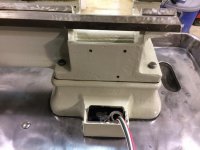duckfarmer27
Stainless
- Joined
- Nov 4, 2005
- Location
- Upstate NY
I'm in the process of putting my Heavy 10 back together. Shipped January 1945. Per the card the electrical components on it are original. It has a manual motor starter (with proper heaters installed) mounted on the back side of the bed - see pictures. When I tore this apart there was a fair amount of swarf and oil that had migrated into the opening in the Headstock End Leg, as SB called it, where the wiring from the motor terminates. I should note this lathe is mounted on a cabinet. There is a slightly variable gap between the casting and the bottom of the starter box, maximum opening probably 1/4 inch.
I'm not that familiar with these and am just curious as to why there seemed to be no sealing between the casting and the box. My solution is going to be RTV - unless there is some part missing.
Probably can chalk this one up to SB trivia as I realize there were several different options as to how these were wired. And apologies for the Iphone pictures which rotate between my computer and here.
Dale
I'm not that familiar with these and am just curious as to why there seemed to be no sealing between the casting and the box. My solution is going to be RTV - unless there is some part missing.
Probably can chalk this one up to SB trivia as I realize there were several different options as to how these were wired. And apologies for the Iphone pictures which rotate between my computer and here.
Dale





